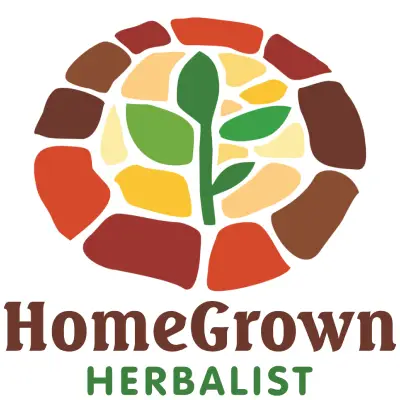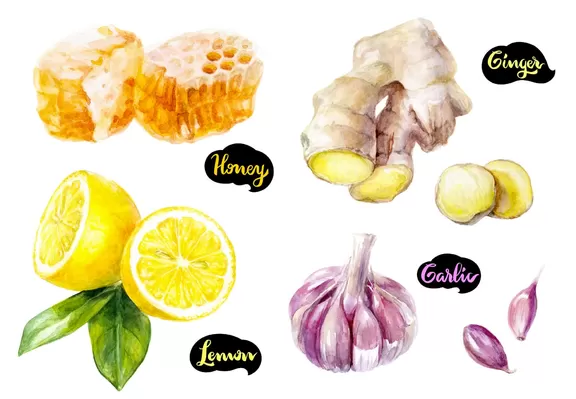
Ginger (Zingiber officinale) is able to stop the growth of some of the most prevalent fungal pathogens. As research we will discuss proves, ginger is able to combat the fungal pathogens responsible for ringworm / tinea and yeast infections. Thus it can be used for things like athlete’s foot (tinea pedis) and yeast infections of many kinds.
There are a lot of different types of fungal infections, and it would probably take an entire book dedicated to explaining if ginger can be used for each unique infection. Yet, it is reasonable to extrapolate that ginger might be a great treatment option for any fungal infection. So, in general, yes; ginger is often a very capable antifungal herb. Certainly worth considering to stock in a home apothecary.
This article will cover some of the most common (tineas and yeast infections) fungal infections; and, show how ginger does work to stop the pathogens responsible for these conditions. So, if you have some form of tinea (jock itch, ringworm, athlete’s foot) or yeast infection (candidiasis), ginger can be used to treat it.
It should be noted that ginger may not inhibit certain types of fungus. Ginger is sometimes fermented, and some fungi can be used to ferment this herb (more on fermented ginger here). Therefore, it appears some types of fungi are not well inhibited by ginger. Yet, this selective action also takes place concerning bacteria; some probiotic bacteria seem to be able to withstand ginger. Yet, conversely, many pathogenic bacteria are greatly inhibited by ginger.
So, as with any herb, its antifungal ability is generally dependent upon the context; as different fungal species are affected differently by herbs.
Dr. John Herzog (MD)
Dr. John Herzog, a "survival surgeon" from Maine explains what home remedies work best in a crisis situation.
This may be important in the event you require first-aid or are in an emergency situation without easy access to a hospital. Dr. John Herzog has assembled a large collection of home remedies for such scenarios.

Ginger’s Ability Against Dermatophytes

According to a study published in Current Fungal Infection Reports [9.3 (2015): 164-179],(source 1) dermatophytes are one of the most common causes of skin diseases in the world; and the true prevalence is probably underestimated. Dermatophytosis affects about 25% of the world population.(source 2)
These types of infections are called "tinea;" and are further named according to the place of infection. Ringworm is another name for tinea infections. For example, tinea pedis (athlete’s foot) is so named as this is a dermatophyte infection of the foot. Likewise tinea capitis involves the scalp.
Dermatophytes are some of the most common fungal agents causing superficial skin infections. The genera of fungi responsible for these infections are Epidermophyton, Trichophyton and Microsporum. Yet, Trichophyton fungi seem to be the principal infective organism. The species Trichophyton rubrum (T. rubrum) is the main cause of all dermatophyte infections.(source 2)
Ginger’s Effect on Trichophyton rubrum
A study published in the Biodiversitas Journal of Biological Diversity [22.3 (2021)](source 3) looked at how three types of ginger would affect T. rubrum. To make an extract, 100 grams of powdered ginger was placed in 300 mL of ethanol (drinking alcohol) for 24 hours. The fluid was then extracted and filtered. After further processing, the crude extract was collected.
The study determined the inhibition zone the extract created for T. rubrum. That is, a small amount of the extract was placed on a growing medium with T. rubrum. The area around the extract where T. rubrum did not grow is the inhibition zone; i.e., the zone where organism growth did not occur.
For a 0.1 mg / mL concentration of each extract the inhibition zones were approximately:
- For Zingiber officinale. var. rubrum: 14mm
- For Zingiber officinale var. officinarum: 13mm
- For Zingiber officinale var. amarum: 11mm
Ginger’s Effect on Trichophyton mentagrophytes
Research published in the Asian Journal of Pharmaceutical and Clinical Research [vol. 10, no. 1, Jan. 2017](source 4) looked at how ginger would impact Trichophyton mentagrophytes (T. mentagrophytes). The study used several herbs, one of them being Zingiber officinale (ginger). Interestingly, the study also tested combinations of herbs on fungal pathogens.
The ginger extract used in this research was created by first drying the herb in an oven. This, again, would cause shogaols to be created from gingerols naturally present in ginger. The ginger was then ground into a powder and extracted with 96% ethanol (drinking alcohol). The extract was then concentrated with an evaporator.

Comprehensive Herbalist School
Dr. Patrick Jones, founder of the HomeGrown Herbalist School of Botanical Medicine has been a practicing veterinarian for over 25 years. He is also a clinical herbalist and traditional naturopath.
Kevin Harrington, Original Shark from ABC’s Shark Tank, stands behind Dr. Patrick Jones and HomeGrown Herbalist.
Learn More
Comprehensive Herbalist School
Dr. Patrick Jones, founder of the HomeGrown Herbalist School of Botanical Medicine has been a practicing veterinarian for over 25 years. He is also a clinical herbalist and traditional naturopath.
Kevin Harrington, Original Shark from ABC’s Shark Tank, stands behind Dr. Patrick Jones and HomeGrown Herbalist.Learn More
The study found the minimum inhibitory concentration (MIC; the lowest concentration that will stop the growth of an organism) and the minimum fungicidal concentration (MFC; the lowest concentration of a substance that will kill an organism) of the ginger extract for T. mentagrophytes. It also found the zone of inhibition (ZOI) created by the extract against T. mentagrophytes.
Note that the results are displayed in µg / mL; this stands for micrograms per milliliter—denoting a level of concentration. This data is as follows:
- MIC: 64µg / mL
- MFC: 512µg / mL
- 8% Ginger Extract ZOI: approximately 16.33mm
Ginger’s Effect on Microsporum gypseum
A study published in the International Journal of Research in Pharmaceutical Sciences [2020](source 5) looked at how ginger would affect Microsporum gypseum (M. gypseum).
The study made their extract from ginger collected at a local market. The ginger was allowed to dry in the shade before using it to make an extract. This drying may have allowed for gingerols (phenolic compounds in ginger) to be converted into shogaols (created from gingerols via drying or heating). The dried ginger was then ground into a powder. Various solvents were used to make the extracts; including water and ethanol.
The study found that ginger was able to create a zone of inhibition and inhibit the growth of M. gypseum. The ethanol extract performed much better at inhibiting this fungus than the aqueous extract did.
Going back to the aforementioned Asian Journal of Pharmaceutical and Clinical Research [vol. 10, no. 1, Jan. 2017](source 4) study; this research also was conducted on M. gypseum. The results of the tests of ginger extract against this fungus is as follows:
- MIC: 128µg / mL
- MFC: 1024µg / mL
- 8% Ginger Extract ZOI: approximately 15.20mm
Claire Goodall’s Amazing Guide
Clair Goodall is a bee-obsessed, natural medicine convert from Minnesota (USA). And, she does keep bees!
Clair has created 350+ page book documenting how to replace the toxic products and medications in your home with healthier, all-natural alternatives.

Ginger for Yeast Infections

Yeast infections often occur in the vaginal area, but can happen in other parts of the body as well. Yeast infections are typically caused by a species of yeast in the genera Candida. Medical research often calls vaginal yeast infections vulvovaginal candidiasis; as Candida is responsible for the infection the vast majority of the time.
Candida can sometimes become resistant to synthetic antifungal drugs. This is where natural medicines really take their place; as they can inhibit and kill Candida where a synthetic drug (like fluconazole) might fail.
Additionally, many studies have been conducted on natural treatments for Candida used in tandem with synthetic drugs. These studies often point to the fact that the combination of an herb with an antifungal drug seem to produce a more efficacious treatment. Therefore, even if you are using a prescription or over the counter drug, ginger would be a great addition to your treatment plan!
Concerning the species of Candida that cause infection, the primary culprit is Candida albicans (C. albicans). Yet, other non-albicans cause a minority of infections.
The most notable minor cause of candidiasis is probably C. glabrata. Yet, it is reasonable to assume that research which demonstrates ginger can fight one or two species of Candida, can be used to extrapolate this herb’s effects on other species of Candida. They are all in the same genus of fungi, of course!

HomeGrown Herbalist Herb Shoppe
Owner of HomeGrown Herbalist Dr. Patrick Jones is a practicing veterinarian, Clinical Herbalist, and traditional naturopath. He owns and operates Fairview Animal Hospital in Buhl, ID.
Their herb shoppe provides herbs, essential oils, and tools. If you have some time, check it out!
Learn More
HomeGrown Herbalist Herb Shoppe
Owner of HomeGrown Herbalist Dr. Patrick Jones is a practicing veterinarian, Clinical Herbalist, and traditional naturopath. He owns and operates Fairview Animal Hospital in Buhl, ID.
Their herb shoppe provides herbs, essential oils, and tools. If you have some time, check it out!Learn More
Further information concerning the species of Candida causing infection, a study published in Cold Spring Harbor Perspectives in Medicine [4.9 (2014)](source 6) relates the following statistics:
Candida species are the most common causes of fungal infection. Approximately 90% of infections are caused by five species: Candida albicans, Candida glabrata, Candida tropicalis, Candida parapsilosis, and Candida krusei…
The five species most commonly associated with candidiasis are Candida albicans (65.3%), Candida glabrata (11.3%), Candida tropicalis (7.2%), C. parapsilosis (6.0%), and Candida krusei (2.4%)... C. albicans remains the most commonly isolated, but the proportion relative to other Candida species has decreased over time (from 71% to 65%). This was accompanied by an increasing incidence of C. glabrata, C. tropicalis, and C. parapsilosis.
Cold Spring Harbor Perspectives in Medicine [4.9 (2014)]
So we see that C. albibicans causes about 65% of candida infections; and, the other Candida species account for smaller incidences of infections.
How Ginger Affects C. albicans & C. krusei
A study published in the American Journal of Applied Sciences [6.6 (2009)](source 7) looked at how ginger would affect C. albicans. The study used 99% ethanol to create their ginger extract.
The study found that the MIC of their ginger extract against C. albicans was 2mg / mL. The study also found the zone of inhibition (ZOI) the extract created when placed with C. albicans. The ZOI for an exact dilution of 1/5 against C. albicans was about 9mm2. The ZOI for a dilution of 1/125 was about 8mm2.
Another study, published in the Jundishapur Journal of Microbiology [9.2 (2016)](source 8) also looked at how a ginger extract would affect C. albicans and C. krusei. In addition, the biofilm formation of these yeasts in the presence of ginger was analyzed. The study used an ethanol extract of ginger for their experiments.
Biofilm formation is a key way in which Candida protects and establishes itself. Biofilm is a thick sludge that Candida forms; allowing it to be protected where it grows. Thus, the reduction of biofilm formation by a substance can play a key role in treating an infection.

Comprehensive Herbalist School
Dr. Patrick Jones, founder of the HomeGrown Herbalist School of Botanical Medicine has been a practicing veterinarian for over 25 years. He is also a clinical herbalist and traditional naturopath.
Kevin Harrington, Original Shark from ABC’s Shark Tank, stands behind Dr. Patrick Jones and HomeGrown Herbalist.
Learn More
Comprehensive Herbalist School
Dr. Patrick Jones, founder of the HomeGrown Herbalist School of Botanical Medicine has been a practicing veterinarian for over 25 years. He is also a clinical herbalist and traditional naturopath.
Kevin Harrington, Original Shark from ABC’s Shark Tank, stands behind Dr. Patrick Jones and HomeGrown Herbalist.Learn More
This study found the MIC for the ethanolic ginger extract against C. albicans to be 10mg / mL. Against C. krusei, the MIC for the extract was 5mg / mL.
Concerning biofilm formation, a reduction in biofilm was seen at an extract concentration of 0.625mg / mL for C. albicans. At 40mg / mL there was no detectable biofilm from C. albicans.
Ginger’s Side Effects
Ginger is a very safe herb, and generally will not cause any problems for most people. Yet, possibly the most common side effect is upset stomach or heartburn—espcially if a lot is taken on an empty stomach.
Although ginger has the US FDA’s “generally regarded as safe” (GRAS) certification, there are still some side effects and warnings to be aware of. Possibly the two most important are that this herb should not be taken with blood thinners. And, if you have a history of gallstones, you should avoid this herb.
There are more side effects, drug interactions, and contraindications for ginger; but, are beyond the scope of this article. Herbsey has a full article dedicated to this topic. If you have some time, it is a thorough overview of the side effects of ginger. You can find it here: Ginger’s Side Effects.
About the Author
Nick Gross is a natural medicine enthusiast who has been researching and writing about natural medicine since 2008. Nick is primarily a web developer, but also researches and authors written and video content about natural health. Nick has a bachelor’s degree in Management Information Systems from the University of Northern Iowa.
More on Nick GrossImportant Disclosures & Disclaimers
It is important to use the information you find on Herbsey.com in the right way. Also for legal reasons, these disclaimers and disclosures are necessary. For further information about each, feel free to click the link provided to the page on this website that provides more information.
Medical Disclaimer
The information on this website is not a prescription for anyone. This information is for informational or educational purposes only, and is not a substitute for professional medical advice or consultations with healthcare professionals.
Advertisement Disclosure
Some of the links provided on this article and website are affiliate links. If you purchase a product after clicking on these links, Herbsey.com will earn a commission. Herbsey.com promotes various products through advertisement and text links. For more information: Our Advertisements.







